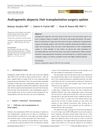TLDR The Artas robotic system is effective and reliable for hair transplants.
The study evaluated the effectiveness of the Artas robotic hair transplant system in performing Follicular Unit Extraction (FUE). The focus was on assessing the rate of unsuccessful harvest attempts, where no actual hair follicular unit graft was produced. The findings provided insights into the efficiency and reliability of the robotic system in hair transplantation procedures, contributing valuable data to the dermatology field, which had limited literature on this topic at the time.
 5 citations
,
September 2012 in “Dermatology Online Journal”
5 citations
,
September 2012 in “Dermatology Online Journal” Follicular Unit Extraction (FUE) hair transplant is less invasive, leaves no scars, and has quicker recovery times, but it's more time-consuming and challenging. Automation helps speed up the process and improve graft survival, reducing the need for traditional strip surgery.
 30 citations
,
June 2008 in “Dermatologic Surgery”
30 citations
,
June 2008 in “Dermatologic Surgery” The SAFE System may improve hair transplant results but isn't suitable for everyone.
 1 citations
,
January 2021 in “Dermatological reviews”
1 citations
,
January 2021 in “Dermatological reviews” Hair transplantation improves androgenetic alopecia with high patient satisfaction.
 4 citations
,
August 2018 in “Journal of Cosmetic Dermatology”
4 citations
,
August 2018 in “Journal of Cosmetic Dermatology” Actual harvested hair follicles were fewer and differed in type from estimated, with older patients and those with multiple transplants needing more careful planning.
2 citations
,
May 2002 in “PubMed” Micro-graft hair transplantation is an effective, simple, and painless method for permanent hair restoration in men and women.



